Thermostratigraphic and Heat Flow Assessment of the South Slave Region in the Northwest Territories, Canada
Abstract
:1. Introduction
2. Geological Setting

3. Input Data
3.1. Temperature Data
3.1.1. South Slave Region
3.1.2. Cameron Hills
3.2. Thermal Conductivity and Heat Generation Rate
3.2.1. South Slave Region
3.2.2. Cameron Hills
4. Methods
4.1. Drilling Disturbance Correction for BHTs
4.2. Paleoclimate Correction
4.3. Geothermal Gradient Calculation
4.4. Verification with Temperature Profiles from Cameron Hills
4.4.1. Heat Flow Evaluation for Cameron Hills
4.4.2. Temperature–Depth Models for Cameron Hills
4.5. Prediction of Temperature Profiles for South Slave Communities
4.5.1. Heat Flow Evaluation for South Slave Communities
4.5.2. Temperature–Depth Model
5. Results
5.1. Corrected BHTs
5.2. Paleoclimate Correction
5.3. Geothermal Gradient
5.4. Verification with Temperature Profiles from Cameron Hills
5.4.1. Heat Flow Evaluation for Cameron Hills
5.4.2. Temperature–Depth Model
5.5. Prediction of Temperature Profiles for South Slave Communities
5.5.1. Heat Flow Evaluation for South Slave Communities
5.5.2. Temperature–Depth Model
6. Discussion
7. Conclusions
Supplementary Materials
Author Contributions
Funding
Data Availability Statement
Acknowledgments
Conflicts of Interest
References
- Jessop, A.M. Chapter 3—Analysis and Correction of Heat Flow on Land. In Developments in Solid Earth Geophysics; Jessop, A.M., Ed.; Elsevier: Amsterdam, The Netherlands, 1990; Volume 17, pp. 57–85. [Google Scholar] [CrossRef]
- Majorowicz, J.; Šafanda, J.; Torun-1 Working Group. Heat flow variation with depth in Poland: Evidence from equilibrium temperature logs in 2.9-km-deep well Torun-1. Int. J. Earth Sci. 2008, 97, 307–315. [Google Scholar] [CrossRef]
- Augustine, C.; Tester, J.W.; Anderson, B.; Petty, S.; Livesay, B. A comparison of geothermal with oil and gas well drilling costs. In Proceedings of the 31st Workshop on Geothermal Reservoir Engineering, Stanford, CA, USA, 30 February 2006. [Google Scholar]
- Bédard, K.; Comeau, F.-A.; Raymond, J.; Malo, M.; Nasr, M. Geothermal Characterization of the St. Lawrence Lowlands Sedimentary Basin, Québec, Canada. Nat. Resour. Res. 2018, 27, 479–502. [Google Scholar] [CrossRef]
- Grasby, S.; Majorowicz, J.; McCune, G. Geothermal Energy Potential for Northern Communities Open File; Report No: 7350; Her Majesty the Queen in Right of Canada: Ottawa, ON, USA, 2013. [Google Scholar]
- Harrison, W.E.; Luza, K.V.; Prater, M.L.; Reddr, R.J. Geothermal Resource Assessment in Oklahoma Special Paper; Report No: DE-AS07-80ID12172; Oklahoma Geological Survey: Norman, OK, USA, 1983. [Google Scholar]
- Majorowicz, J.; Grasby, S.E. Deep Geothermal Heating Potential for the Communities of the Western Canadian Sedimentary Basin. Energies 2021, 14, 706. [Google Scholar] [CrossRef]
- Grasby, S.; Majorowicz, J.; Fiess, K. Geothermal Energy Potential of Northwest Territories, Canada. In Proceedings of the World Geothermal Congress 2020+1, Reykjavik, Iceland, 24–27 October 2021. [Google Scholar]
- Grasby, S.E.; Allen, D.M.; Bell, S.; Chen, Z.; Ferguson, G.; Jessop, A.; Kelman, M.; Majorowicz, M.; Ko, J.; Moore, M.; et al. Geothermal Energy Resource Potential of Canada Open File (Revised); Report No: 6914.; Natural Resources Canada: Ottawa, ON, Canada, 2011. [Google Scholar]
- EBA Engineering Consultants Ltd. Geothermal Favourability Map Northwest Territories Report 2010; Report No: Y22101146; Northwest Territories Environment and Natural Resources: Yellowknife, NT, Canada, 2010. [Google Scholar]
- Petrel Robertson Consulting Ltd. Geothermal Database Compilation Internal Report; Petrel Robertson Consulting Ltd.: Calgary, AB, Canada, 2022. [Google Scholar]
- OROGO(2022) Well Status files. Office of the Regulator of Oil and Gas Operations. Available online: https://www.orogo.gov.nt.ca/en/resources-0 (accessed on 19 January 2022).
- Smejkal, E.J.; Hickson, C.J.; Collard, J. Revisiting the geothermal potential of the Dehcho Region in NWT: New data from old wells. In Proceedings of the Geoconvention, Calgary, AB, Canada, 15–17 May 2023. [Google Scholar]
- Davenport, P.H. Exploration Areas of the NWT, Yukon and Nunavut; ESRI ArcView® GIS Shapefiles; Geological Survey of Canada: Calgary, AB, Canada, 2001. [Google Scholar]
- Rocheleau, J.; Fiess, K.M. Northwest Territories Oil and Gas Poster Series: Basins & Petroleum Resources, Table of Formations, Schematic Cross Sections Open File. Report No: 2014-03. 2014. Available online: https://www.nwtgeoscience.ca/sites/ntgs/files/content/table_of_formations_2014_0.pdf (accessed on 23 March 2024).
- Carvalho, H.D.S.; Vacquier, V.D. Method for determining terrestrial heat flow in oil fields. Geophysics 1977, 42, 584–593. [Google Scholar] [CrossRef]
- Majorowicz, J.M.; Jessop, A.M. Canadian Sedimentary Basin. Tectonophysics 1981, 74, 209–238. [Google Scholar] [CrossRef]
- Reiter, M.; Jessop, A.M. Estimates of terrestrial heat flow in offshore eastern Canada. Can. J. Earth Sci. 1985, 22, 1503–1517. [Google Scholar] [CrossRef]
- Kenneth, E.P.; Philip, H.N. Criteria to Determine Borehole Formation Temperatures for Calibration of Basin and Petroleum System Models. In Proceedings of the AAPG Annual Convention and Exhibition, Denver, CO, USA, 7–10 June 2009. [Google Scholar]
- Deming, D.; Chapman, D.S. Heat Flow in the Utah-Wyoming Thrust Belt From Analysis of Bottom-Hole Temperature Data Measured in Oil and Gas Wells. J. Geophys. Res. Solid Earth 1988, 93, 13657–13672. [Google Scholar] [CrossRef]
- Dowdle, W.L.; Cobb, W.M. Static Formation Temperature From Well Logs—An Empirical Method. J. Pet. Technol. 1975, 27, 1326–1330. [Google Scholar] [CrossRef]
- Förster, A.; Merriam, D.; Davis, J. Spatial analysis of temperature (BHT/DST) data and consequences for heat-flow determination in sedimentary basins. Int. J. Earth Sci. 1997, 86, 252–261. [Google Scholar] [CrossRef]
- Blackwell, D.D.; Richards, M. Geothermal Map of North America. AAPG Map, scale Calibration of the AAPG Geothermal Survey of North America BHT data base. In Proceedings of the AAPG Annual Meeting, Poster Session, Dallas, TX, USA, 18–21 April 2004. [Google Scholar]
- Blackwell, D.D.; Richards, M.; Stepp, P. Texas Geothermal Assessment for the I35 Corridor East Final Report; Report No: CM709; SMU Geothermal Laboratory: Dallas, TX, USA, 2010. [Google Scholar]
- Kehle, R.O.; Schoeppel, R.J.; Deford, R.K. The AAPG geothermal survey of North America. Geothermics 1970, 2, 358–367. [Google Scholar] [CrossRef]
- Crowell, A.M.; Ochsner, A.T.; Gosnold, W. Correcting Bottom-Hole Temperatures in the Denver Basin: Colorado and Nebraska. In Proceedings of the Geothermal Resources Council Annual Meeting 2012, Reno, NV, USA, 30 September–3 October 2012. [Google Scholar]
- Crowell, A.; Gosnold, W. Correcting Bottom Hole Temperatures: A Look at the Permian Basin (Texas), Williston Basin (North Dakota), Anadarko and Arkoma Basins (Oklahoma). In Proceedings of the Geothermal Resources Council Annual Meeting 2011, San Diego, CA, USA, 23–26 October.2011. [Google Scholar]
- Westaway, R.; Younger, P.L. Accounting for palaeoclimate and topography: A rigorous approach to correction of the British geothermal dataset. Geothermics 2013, 48, 31–51. [Google Scholar] [CrossRef]
- Dyke, A.S. An outline of North American deglaciation with emphasis on central and northern Canada. In Developments in Quaternary Sciences; Ehlers, J., Gibbard, P.L., Eds.; Elsevier: Amsterdam, The Netherlands, 2004; Volume 2, pp. 373–424. [Google Scholar] [CrossRef]
- Lemmen, D.S.; Duk-Rodkin, A.; Bednarski, J.M. Late glacial drainage systems along the northwestern margin of the Laurentide Ice Sheet. Quat. Sci. Rev. 1994, 13, 805–828. [Google Scholar] [CrossRef]
- Stott, D.F.; Klassen, R.W. Geomorphic divisions. In Sedimentary Cover of the Craton in Canada; Stott, D.F., Aitken, J.D., Eds.; Geological Survey of Canada, Geology of Canada: Ottawa, ON, Canada, 1993; Volume 5, pp. 31–44. [Google Scholar]
- Meijer Drees, N.C. The Devonian Succession in the Subsurface of the Great Slave and Great Bear Plains, Northwest Territories; Geological Survey of Canada: Ottawa, ON, Canada, 1993; p. 231. [Google Scholar] [CrossRef]
- Moore, P.F. Devonian. In Sedimentary Cover of the Craton in Canada; Stott, D.F., Aitken, J.D., Eds.; Geological Survey of Canada, Geology of Canada: Ottawa, ON, Canada, 1993; Volume 5, pp. 150–201. [Google Scholar]
- Morrow, D.W.; Geldsetzer, H.H.J. Devonian of the eastern Canadian Cordillera. In Devonian of the World Regional Syntheses; McMillan, N.J., Embry, A.F., Glass, D.J., Eds.; Canadian Society of Petroleum Geologists: Calgary, Canada, 1988; Volume 1, pp. 85–121. [Google Scholar]
- Mossop, G.; Shetsen, I. Geological Atlas of the Western Canada Sedimentary Basin. 1994. Available online: https://ags.aer.ca/reports/atlas-western-canada-sedimentary-basin (accessed on 12 January 2022).
- Gal, L.P.; Jones, A.L. Evaluation of oil and gas potential in the Deh Cho territory Open File; 2003. Report No: 2003-03.
- Wright, G.; McMechan, M.; Potter, D. Structure and architecture of the Western Canada sedimentary basin. In Geological atlas of the Western Canada Sedimentary Basin; Mossop, G., Dixon, J., Eds.; Canadian Society of Petroleum Geologists and Alberta Research Council: Calgary, Canada, 1994; Volume 4, pp. 25–40. [Google Scholar]
- Smith, I.R.; Christine, D.; Grant, H.; Roger, C.P. A drift isopach model for the southwestern Great Slave Lake region, Northwest Territories, Canada. J. Maps 2023, 19, 2147871. [Google Scholar] [CrossRef]
- Morrow, D.W.; MacLean, B.C.; Tzeng, P.; Pana, D. Subsurface Paleozoic Structure and Isopach Maps and Selected Seismic Lines in Southern Northwest Territories and Northern Alberta: Implications for Mineral and Petroleum Potential Open File; Report No: 4366; Geological Survey of Canada: Calgary, Canada, 2002. [Google Scholar]
- Northwest Territories Geological Survey (2023) Geology Map. Available online: https://ntgs-open-data-ntgs.hub.arcgis.com/ (accessed on 2 August 2022).
- Ouzzane, M.; Eslami-nejad, P.; Badache, M.; Aidoun, Z. New correlations for the prediction of the undisturbed ground temperature. Geothermics 2015, 53, 379–384. [Google Scholar] [CrossRef]
- Environment and Climate Change Canada (2019) Historical Climate Data. Canada: Government of Canada. Available online: http://climate.weather.gc.ca/ (accessed on 20 April 2023).
- Rajaobelison, M.; Thibault, M.; Comeau, F.-A.; Raymond, J.; Terlaky, V. Laboratory analyses on split core samples from wells to assess the geothermal potential of the South Slave Region, Northwest Territories; Report No: OR 2023-015. Can. Open Rep. 2023, in press. [Google Scholar]
- Clauser, C. Thermal Storage and Transport Properties of Rocks, I: Heat Capacity and Latent Heat. In Encyclopedia of Solid Earth Geophysics; Gupta, H.K., Ed.; Springer: Dordrecht, The Netherlands, 2011; pp. 1423–1431. [Google Scholar] [CrossRef]
- Beardsmore, G.; Cull, J. Crustal Heat Flow: A guide to Measurement and Modelling, 1st ed.; Cambridge University Press: New York, NY, USA, 2001; p. 324. [Google Scholar] [CrossRef]
- Jaupart, C.; Mareschal, J.-C. Heat Generation and Transport in the Earth; Cambridge University Press: New York, NY, USA, 2010; p. 462. [Google Scholar]
- Popov, Y.A.; Beardsmore, G.; Clauser, C.; Roy, S. ISRM suggested methods for determining thermal properties of rocks from laboratory tests at atmospheric pressure. Rock Mech. Rock Eng. 2016, 49, 4179–4207. [Google Scholar] [CrossRef]
- Clauser, C.; Huenges, E. Thermal conductivity of rocks and minerals. In Rock Physics and Phase Relations; Ahrens, T.J., Ed.; AGU Reference Shelf 3: Washington, DC, USA, 1995; pp. 105–126. [Google Scholar] [CrossRef]
- Eppelbaum, L.; Kutasov, I.; Pilchin, A. Applied Geothermics, ed.; Springer: Heidelberg, Germany; New York, NY, USA; Dordrecht, The Netherlnds; London, UK, 2014; p. 757. [Google Scholar] [CrossRef]
- Larmagnat, S.; Lavoie, D.; Rajaobelison, M.M.; Raymond, J. Geothermal Assessment of a Conventional Hydrocarbon Reservoir in Eastern Québec: Preliminary Field and Petrophysical Data Open File; Report No: 8597; Geological Survey of Canada, Geology of Canada: Ottawa, ON, Canada, 2019. [Google Scholar]
- Mielke, P.; Bär, K.; Sass, I. Determining the relationship of thermal conductivity and compressional wave velocity of common rock types as a basis for reservoir characterization. J. Appl. Geophys. 2017, 140, 135–144. [Google Scholar] [CrossRef]
- Tang, B.; Zhu, C.; Xu, M.; Chen, T.; Hu, S. Thermal conductivity of sedimentary rocks in the Sichuan basin, Southwest China. Energy Explor. Exploit. 2018, 37, 691–720. [Google Scholar] [CrossRef]
- Cermak, V.; Rybach, L. Thermal Conductivity and Specific Heat of Minerals and Rocks. In Physical Properties of Rocks · SubVolume A; Angenheister, G., Ed.; Springer: Berlin/Heidelberg, Germany; New York, NY, USA, 1982; Volume 1A, pp. 305–343. [Google Scholar] [CrossRef]
- Pasquale, V.; Verdoya, M.; Chiozzi, P. Measurements of rock thermal conductivity with a Transient Divided Bar. Geothermics 2015, 53, 183–189. [Google Scholar] [CrossRef]
- Bücker, C.; Rybach, L. A simple method to determine heat production from gamma-ray logs. Mar. Pet. Geol. 1996, 13, 373–375. [Google Scholar] [CrossRef]
- Hasterok, D.; Gard, M.; Webb, J. On the radiogenic heat production of metamorphic, igneous, and sedimentary rocks. Geosci. Front. 2018, 9, 1777–1794. [Google Scholar] [CrossRef]
- Waples, D.W. A New Model for Heat Flow in Extensional Basins: Estimating Radiogenic Heat Production. Nat. Resour. Res. 2002, 11, 125–133. [Google Scholar] [CrossRef]
- Burrus, J.; Foucher, J.P. Contribution to the thermal regime of the Provençal Basin based on Flumed heat flow surveys and previous investigations. Tectonophysics 1986, 128, 303–334. [Google Scholar] [CrossRef]
- Richards, M.; Crowell, A.M. (SMU Geothermal Laboratory, Dallas, TX, USA). Personal Communication, 2012.
- Mareschal, J.C.; Jaupart, C. Variations of surface heat flow and lithospheric thermal structure beneath the North American craton. Earth Planet. Sci. Lett. 2004, 223, 65–77. [Google Scholar] [CrossRef]
- Majorowicz, J.; Gosnold, W.; Gray, A.; Safanda, J.; Klenner, R.; Unsworth, M. Implications of post-glacial warming for northern Alberta heat flow-correcting for the underestimate of the geothermal potential. In Proceedings of the Geothermal Resources Council Annual Meeting 2012, Reno, NV, USA, 30 September–3 October.2012. [Google Scholar]
- Beltrami, H.; Gosselin, C.; Mareschal, J.-C. Ground surface temperatures in Canada: Spatial and temporal variability. Geophys. Res. Lett. 2003, 30, 1–6. [Google Scholar] [CrossRef]
- Majorowicz, J.; Chan, J.; Crowell, J.; Gosnold, W.; Heaman, L.M.; Kück, J.; Nieuwenhuis, G.; Schmitt, D.R.; Unsworth, M.; Walsh, N.J.; et al. The first deep heat flow determination in crystalline basement rocks beneath the Western Canadian Sedimentary Basin. Geophys. J. Int. 2014, 197, 731–747. [Google Scholar] [CrossRef]
- Birch, A.F. The effects of Pleistocene climatic variations upon geothermal gradients. Am. J. Sci. 1948, 246, 729. [Google Scholar] [CrossRef]
- Jessop, A.M. The Distribution of Glacial Perturbation of Heat Flow in Canada. Can. J. Earth Sci. 1971, 8, 162–166. [Google Scholar] [CrossRef]
- Stein, C.A. Heat Flow of the Earth. In Global Earth Physics; American Geophysical Union: Washington, DC, USA, 1995; pp. 144–158. [Google Scholar] [CrossRef]
- Turcotte, D.L.; Schubert, G. Geodynamics, 3rd ed.; Cambridge University Press: New York, NY, USA, 2014; p. 615. [Google Scholar]
- Majorowicz, J.; Grasby, S.E. Heat flow, depth–temperature variations and stored thermal energy for enhanced geothermal systems in Canada. J. Geophys. Eng. 2010, 7, 232–241. [Google Scholar] [CrossRef]
- Allan Gray, D.; Majorowicz, J.; Unsworth, M. Investigation of the geothermal state of sedimentary basins using oil industry thermal data: Case study from Northern Alberta exhibiting the need to systematically remove biased data. J. Geophys. Eng. 2012, 9, 534–548. [Google Scholar] [CrossRef]
- Majorowicz, J.A.; Garven, G.; Jessop, A.; Jessop, C. Present Heat Flow Along a Profile Across the Western Canada Sedimentary Basin: The Extent of Hydrodynamic Influence. In Geothermics in Basin Analysis; Förster, A., Merriam, D.F., Eds.; Springer: Boston, MA, USA, 1999; pp. 61–79. [Google Scholar] [CrossRef]
- Beach, R.D.W.; Jones, F.W.; Majorowicz, J.A. Heat flow and heat generation estimates for the churchill basement of the western canadian basin in Alberta, Canada. Geothermics 1987, 16, 1–16. [Google Scholar] [CrossRef]
- Majorowicz, J. Anomalous heat flow regime in the Western margin of the North American Craton, Canada. J. Geodyn. 1996, 21, 123–140. [Google Scholar] [CrossRef]
- Eaton, D.W.; Hope, J. Structure of the crust and upper mantle of the Great Slave Lake shear zone, northwestern Canada, from teleseismic analysis and gravity modelling1. Can. J. Earth Sci. 2003, 40, 1203–1218. [Google Scholar] [CrossRef]
- Yin, Y.; Unsworth, M.; Liddell, M.; Pana, D.; Craven, J.A. Electrical resistivity structure of the Great Slave Lake shear zone, northwest Canada: Implications for tectonic history. Geophys. J. Int. 2014, 199, 178–199. [Google Scholar] [CrossRef]
- Faulds, J.; Coolbaugh, M.; Bouchot, V.; Moeck, I.; Oguz, K. Characterizing structural controls of geothermal reservoirs in the Great Basin, USA, and Western Turkey: Developing successful exploration strategies in extended terranes. Proceedings of World Geothermal Congress, Bali, Indonesia, 25–30 April 2010. [Google Scholar]
- Moeck, I. A new classification scheme for deep geothermal systems based on geologic controls. In Proceedings of the EGU General Assembly Conference Abstracts, Vienna, Austria, 22–27 April 2012. [Google Scholar]
- Rajaobelison, M.; Raymond, J.; Malo, M.; Dezayes, C.; Larmagnat, S. Understanding heat transfer along extensional faults: The case of the Ambilobe and Ambanja geothermal systems of Madagascar. Geothermics 2022, 104, 102455. [Google Scholar] [CrossRef]
- Lindal, B. Industrial and other applications of geothermal energy. Geotherm. Energy Rev. Res. Dev. 1973, 135–148. [Google Scholar]


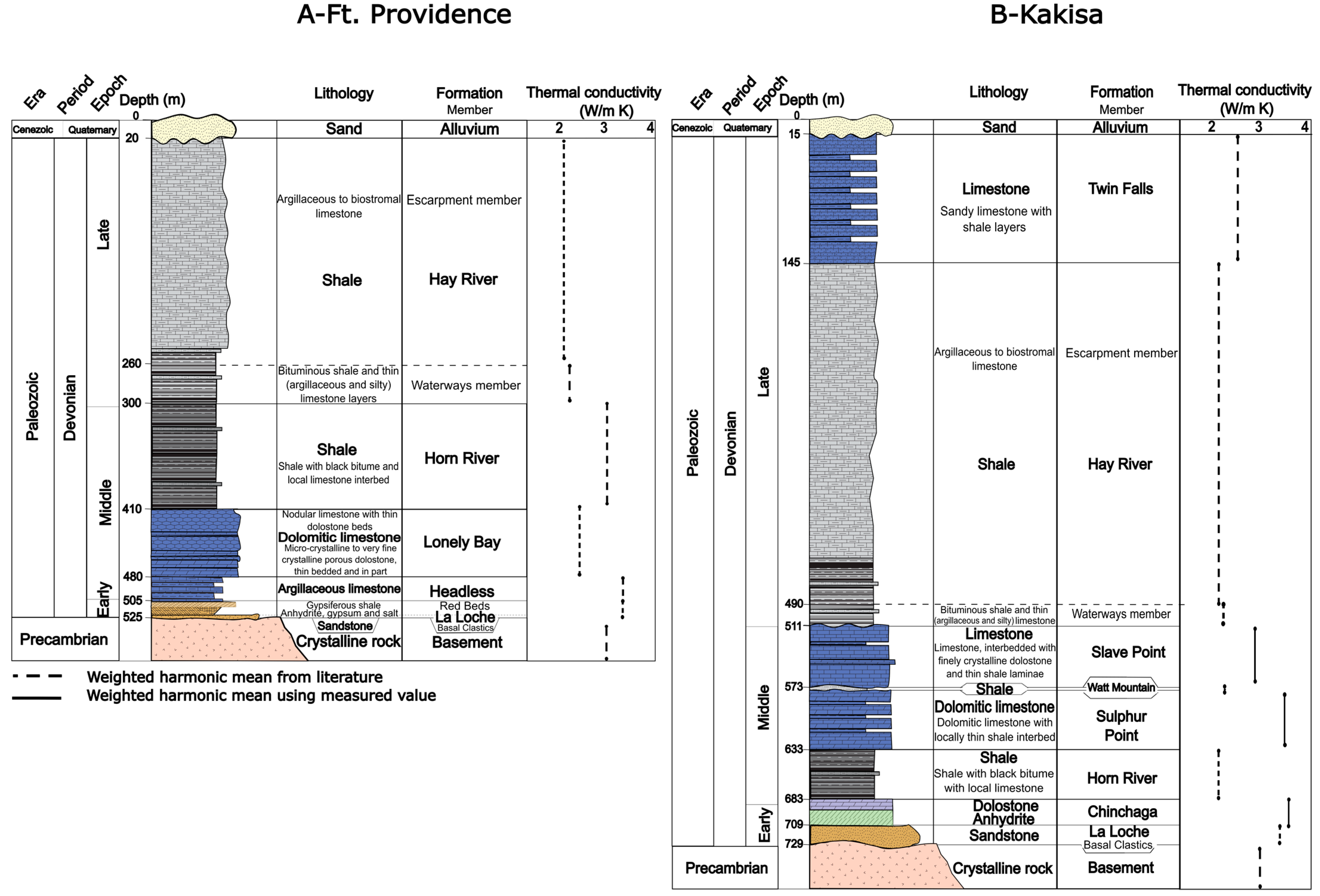

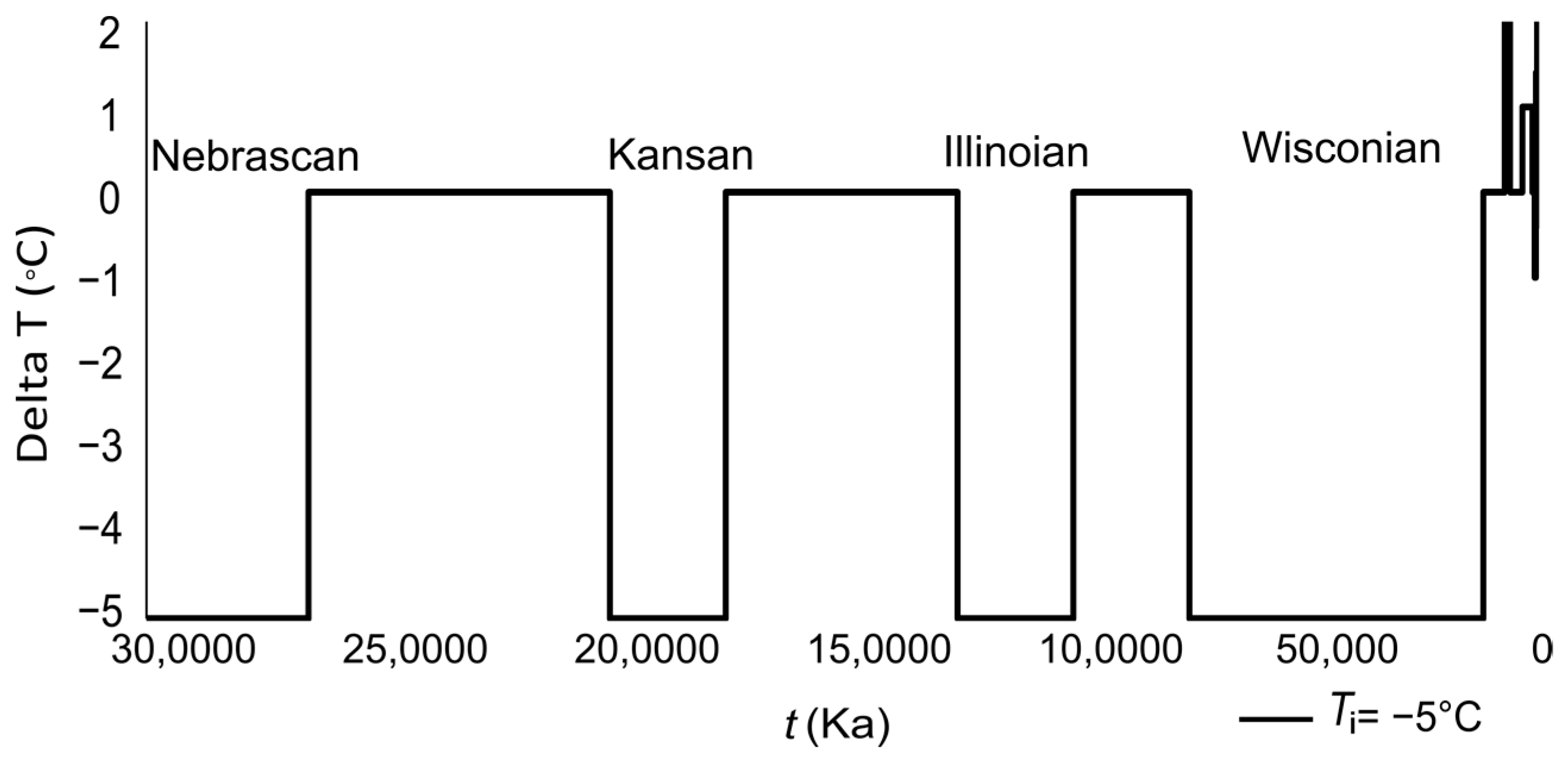
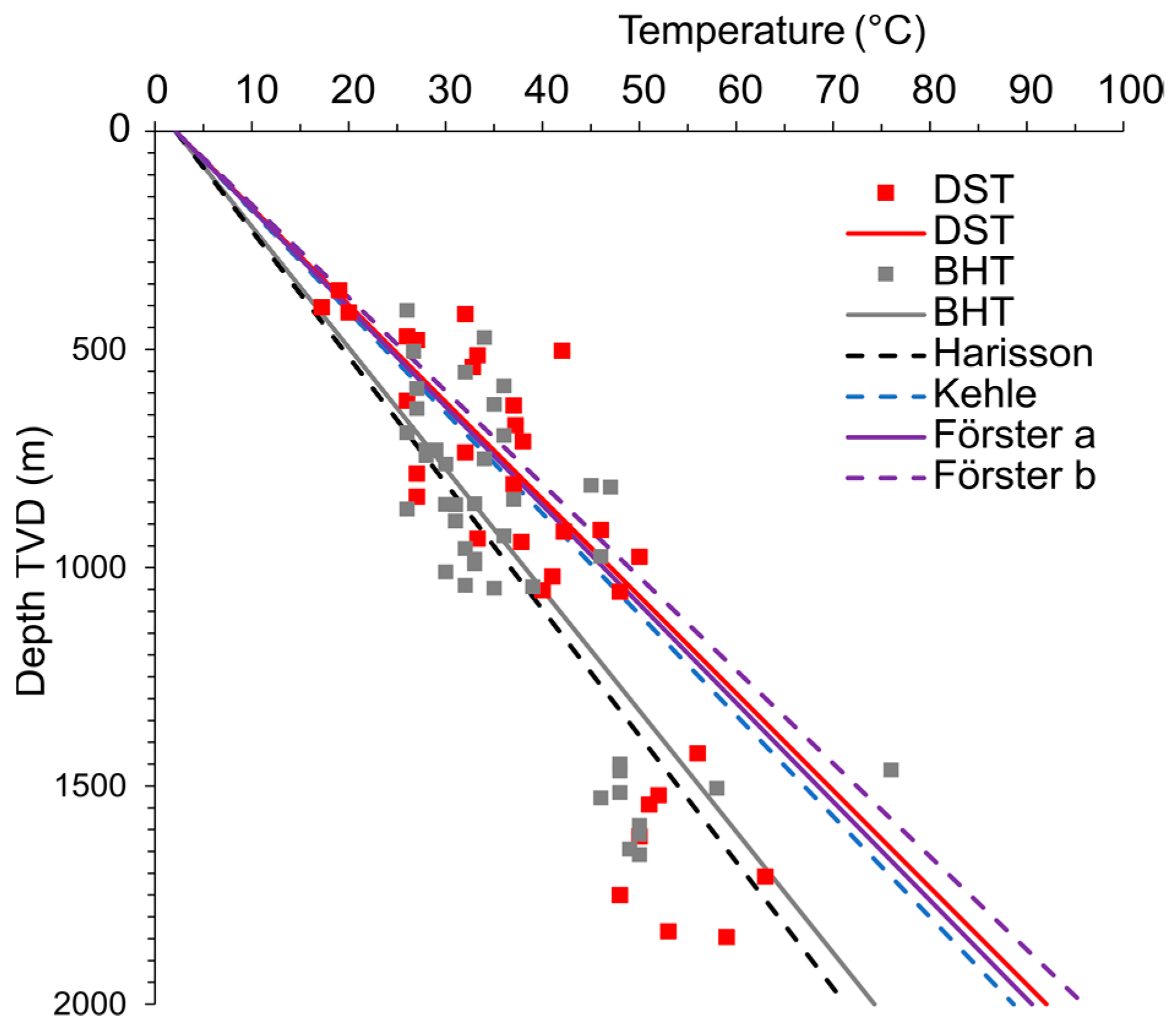
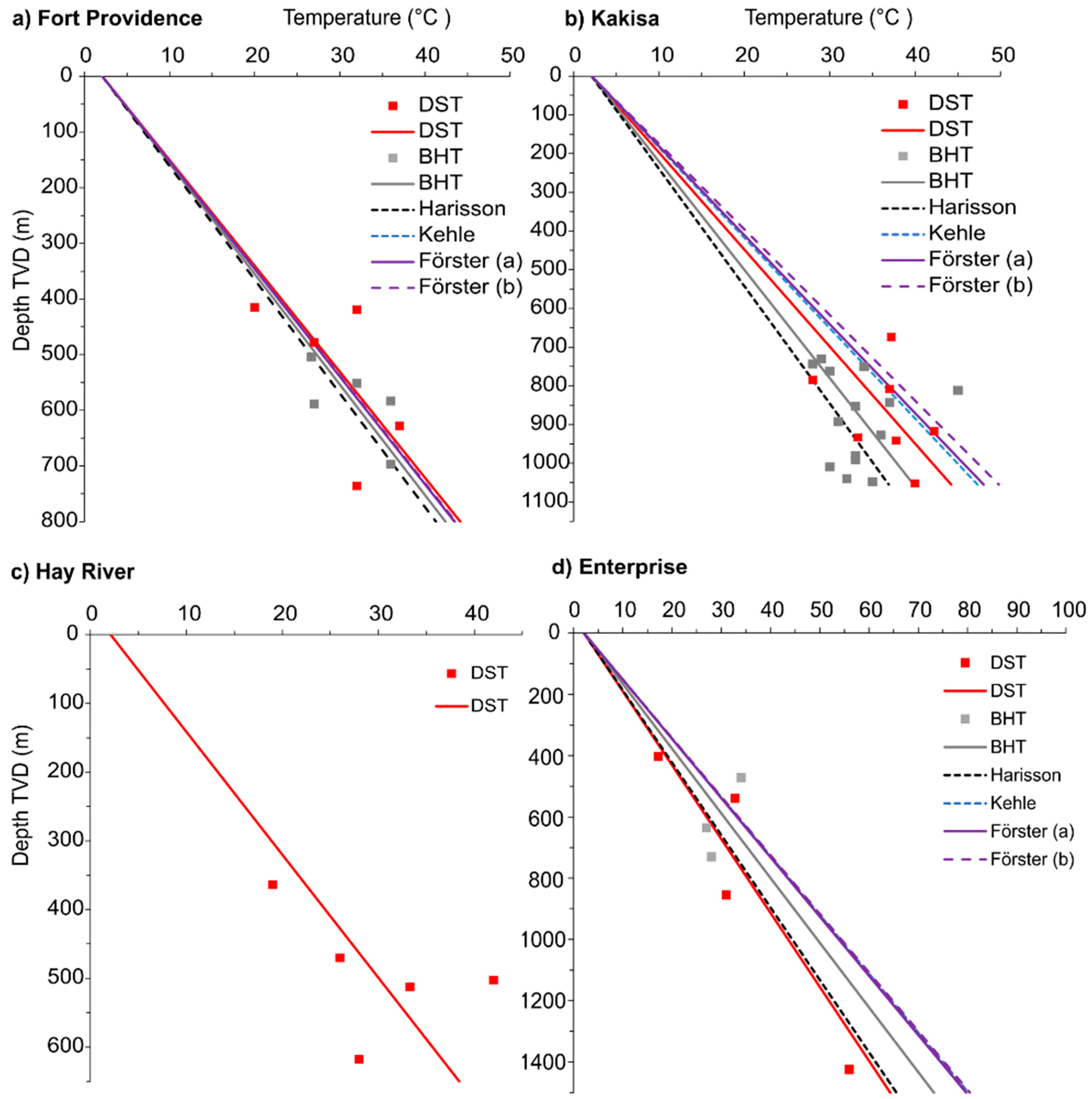
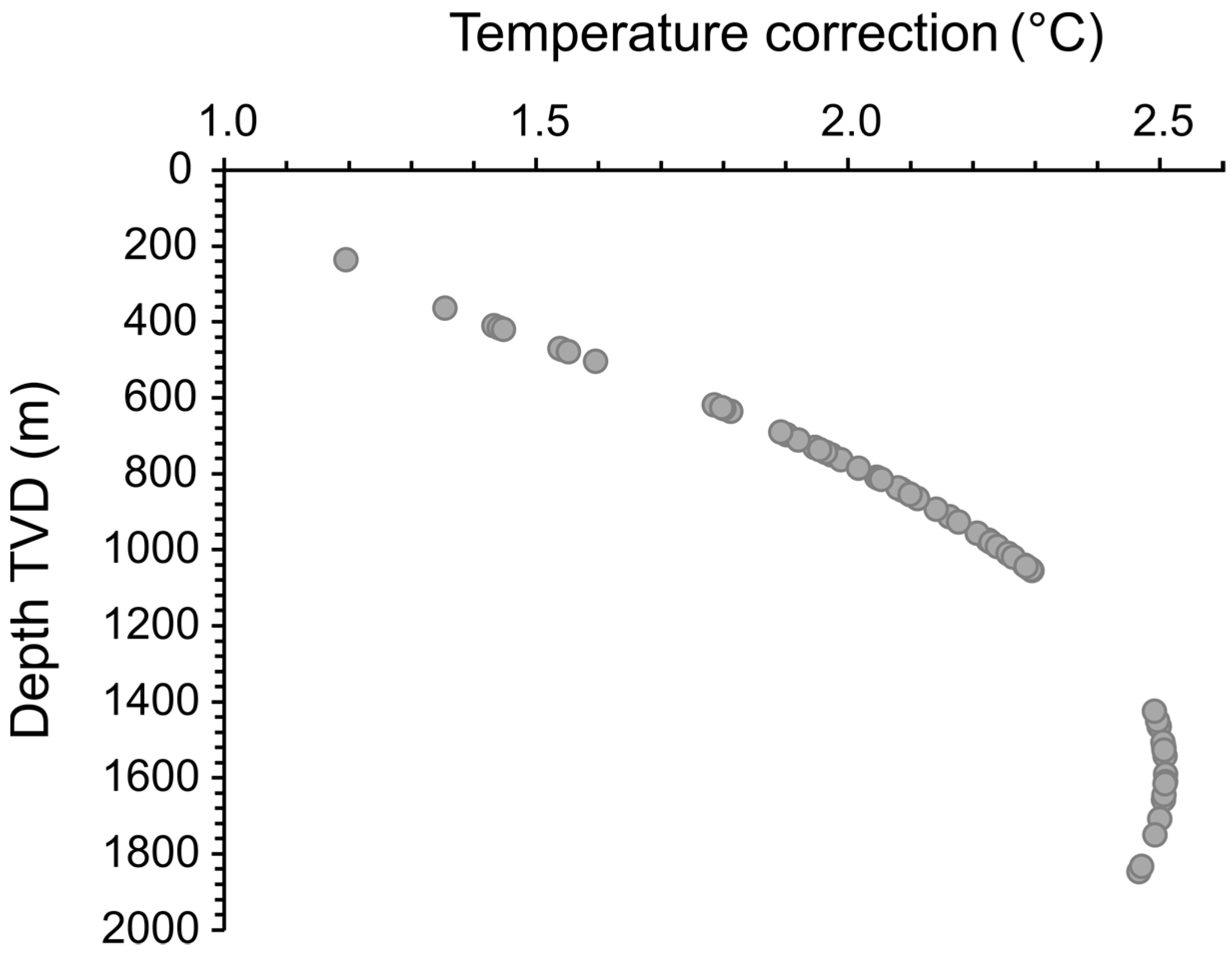

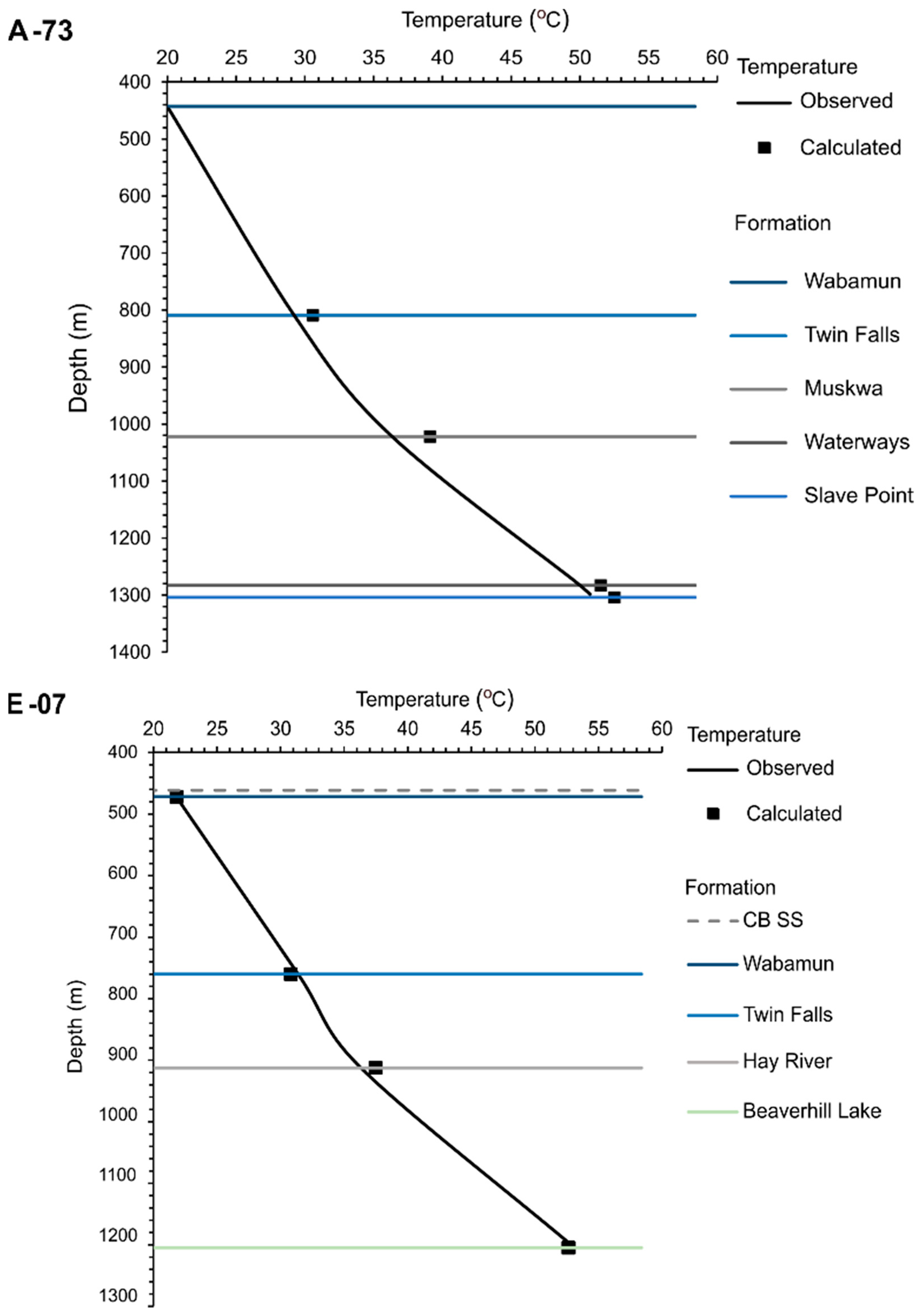
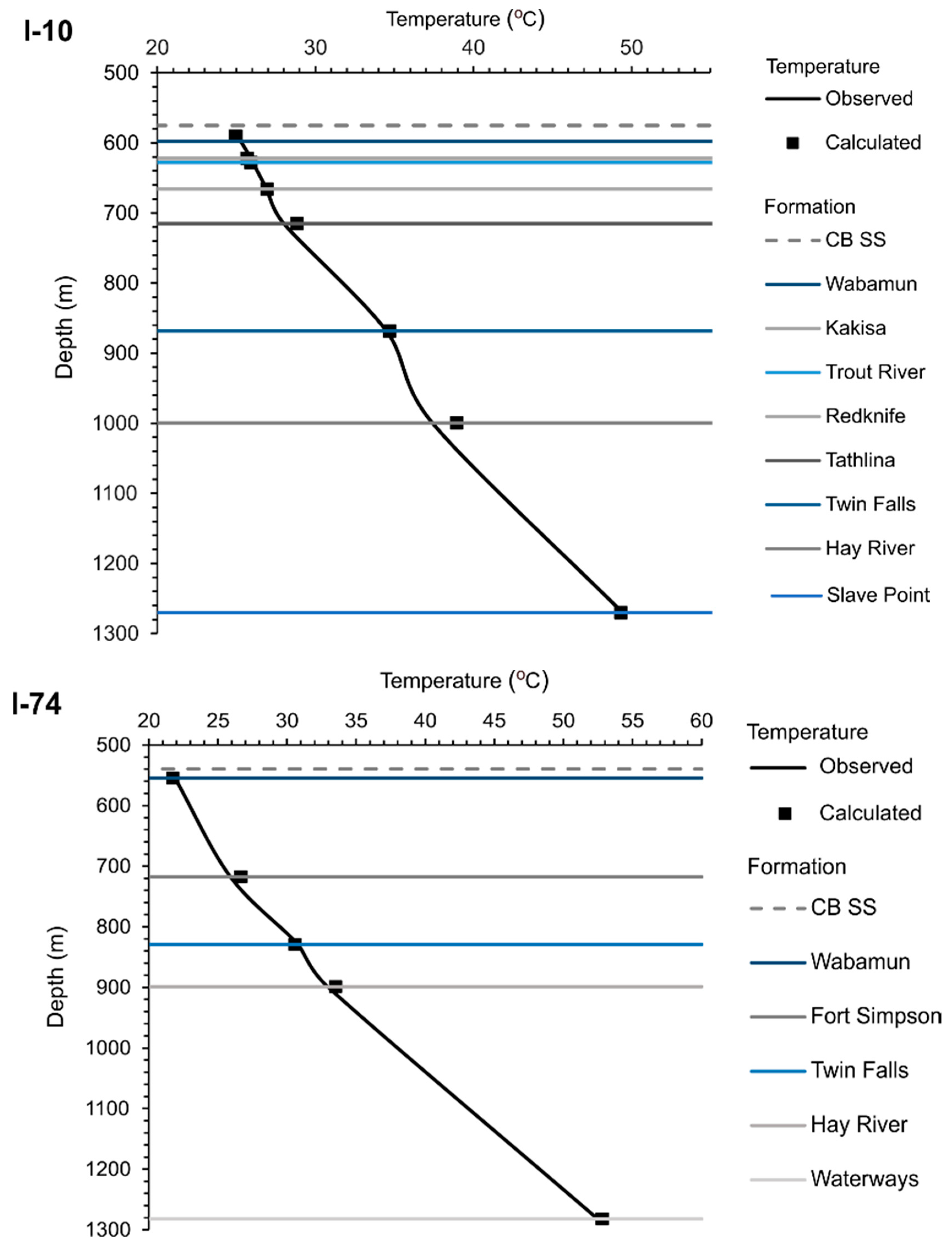

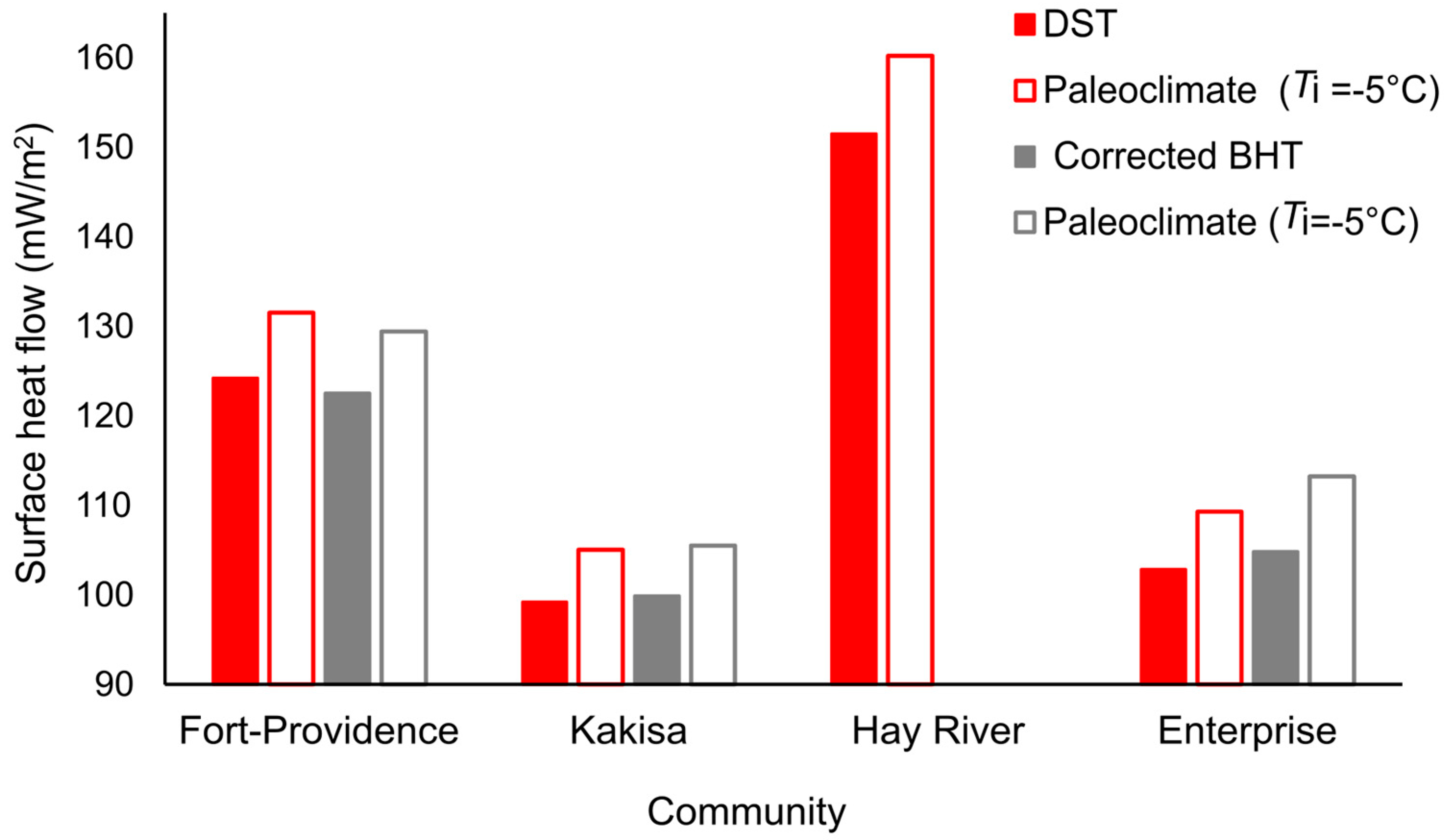
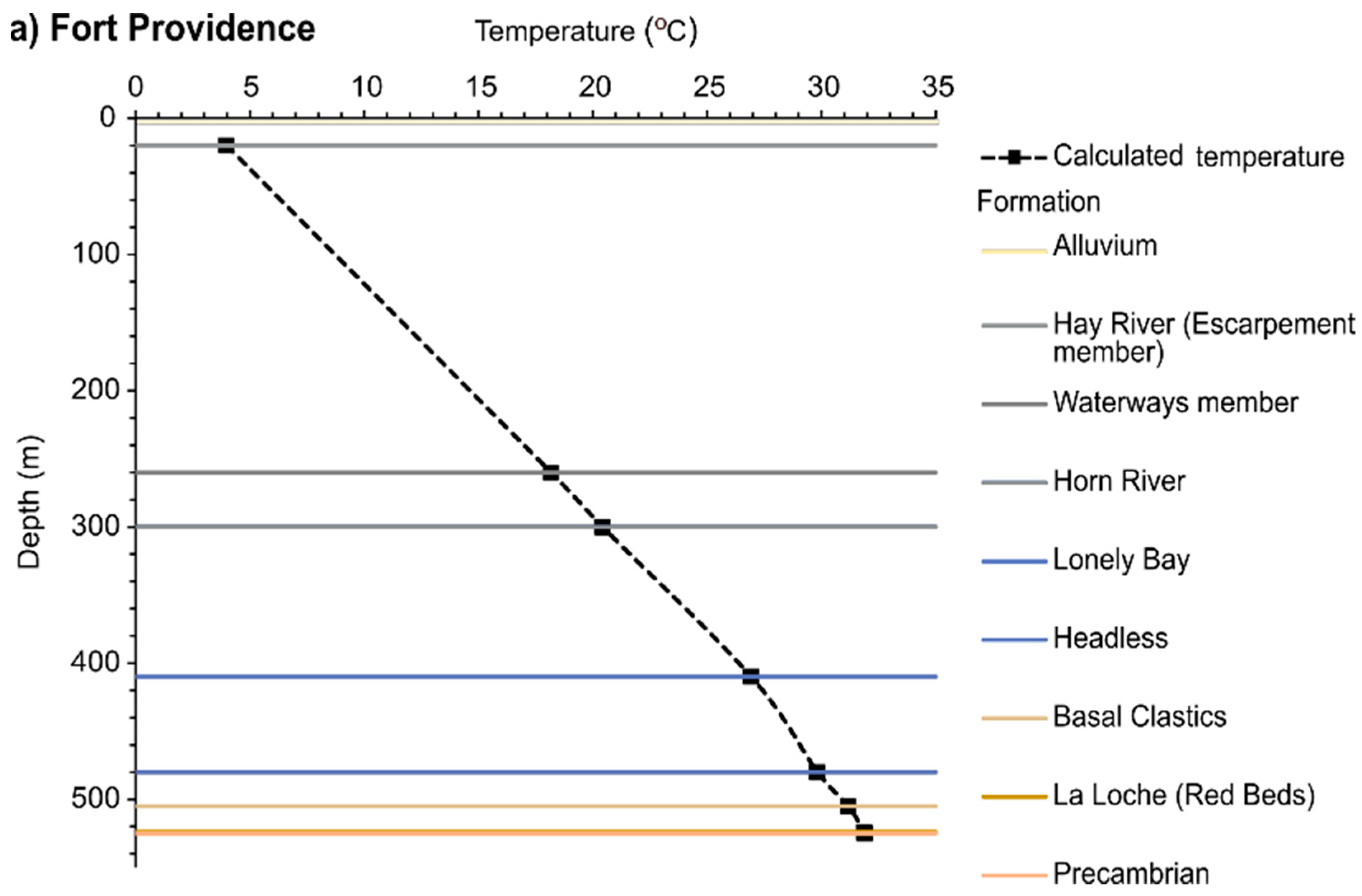
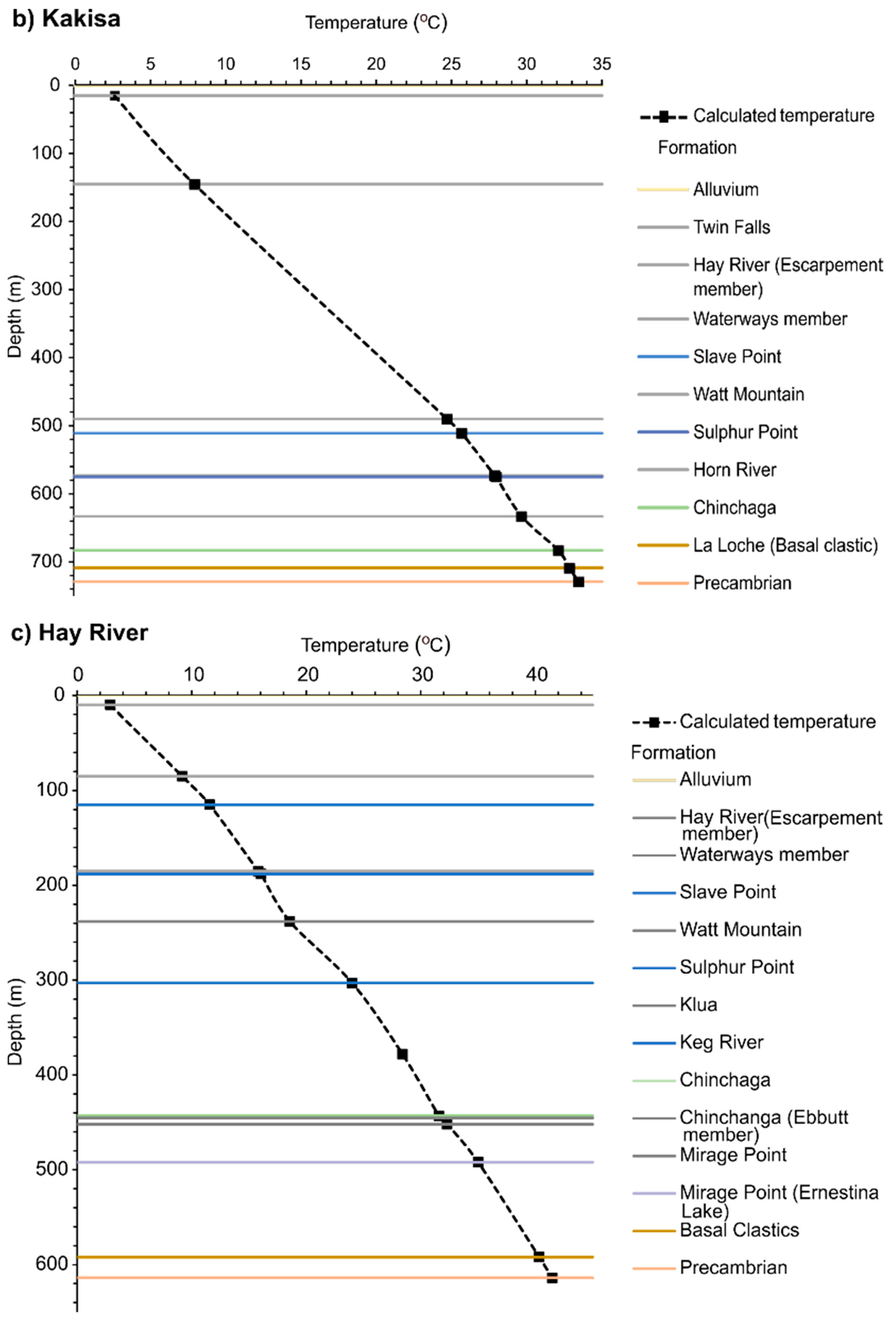

| Data Type | Number of Wells | Depth TVD | Temperature | Source |
|---|---|---|---|---|
| [m] | [°C] | |||
| DST | 20 5 | ≥600–1846 <600 | 19–63 | Petrel Robertson Consulting Ltd. [11] |
| 4 3 | ≥600–941 <600 | 17–42 | OROGO [12] | |
| BHT | 36 5 | ≥600–1657 <600 | 26–76 | Petrel Robertson Consulting Ltd. [11] |
| 1 1 | ≥600 <600 | 27 | OROGO [12] | |
| No data | 41 | Petrel Robertson Consulting Ltd. [11] | ||
| Total | 116 | 49–1949 | 17–76 |
| Formation | Lithology | % | n | Heat Production A [W m−3] | Thermal Conductivity λ [W m−1 K−1] | ||
|---|---|---|---|---|---|---|---|
| Measured | Literature * | Average | |||||
| Alluvium | Sand | 100 | 0.73 × 10−6 | 1.4 | 1.4 | ||
| Twin Falls | Limestone | 95 | 0.19 × 10−6 | 2.5 | 2.5 | ||
| Shale | 5 | 0.53 × 10−6 | 2.1 | ||||
| Hay River | Shale | 92 | 0.53 × 10−6 | 2.1 | 2.1 | ||
| Limestone | 8 | 0.19 × 10−6 | 2.5 | ||||
| Hay River (Escarpment) | Shale | 90 | 0.53 × 10−6 | 2.1 | 2.1 | ||
| Limestone | 10 | 0.19 × 10−6 | 2.5 | ||||
| Hay River (Waterways) | Shale | 60 | 0.53 × 10−6 | 2.1 | 2.2 | ||
| Limestone | 40 | 0.19 × 10−6 | 2.5 | ||||
| Slave Point | Limestone | 92 | 25 | 0.19 × 10−6 | 2.9 ± 0.25 | 2.9 | |
| Shale | 4 | 0.53 × 10−6 | 2.1 | ||||
| Dolostone | 4 | 4 | 0.11 × 10−6 | 4.6 ± 0.55 | |||
| Horn River | Shale | 95 | 0.53 × 10−6 | 2.1 | 2.1 | ||
| Limestone | 5 | 0.19 × 10−6 | 2.5 | ||||
| Watt Mountain | Shale | 92 | 0.53 × 10−6 | 2.1 | 2.2 | ||
| Limestone | 3 | 6 | 0.19 × 10−6 | 3.1 ± 0.18 | |||
| Sandstone | 5 | 0.73 × 10−6 | 3.4 | ||||
| Sulphur Point | Limestone | 78 | 13 | 0.19 × 10−6 | 3.4 ± 0.63 | 3.5 | |
| Dolostone | 20 | 7 | 0.11 × 10−6 | 4.4 ± 0.64 | |||
| Shale | 2 | 0.53 × 10−6 | 2.1 | ||||
| Muskeg | Anhydrite | 90 | 1 | 0.08 × 10−6 | 5.0 ± 0.17 | 3.4 | 4.4 |
| Dolostone | 10 | 6 | 0.11 × 10−6 | 5.6 | |||
| Klua | Shale | 98 | 0.53 × 10−6 | 2.1 | 2.1 | ||
| Limestone | 2 | 0.19 × 10−6 | 2.5 | ||||
| Keg River | Limestone | 90 | 0.19 × 10−6 | 2.8 | 3 | ||
| Dolostone | 10 | 8 | 0.11 × 10−6 | 4.9 ± 0.47 | |||
| Lonely Bay | Dolostone | 50 | 0.11 × 10−6 | 3.8 | 3 | ||
| Limestone | 50 | 0.19 × 10−6 | 2.5 | ||||
| Chinchaga | Anhydrite | 43 | 2 | 0.08 × 10−6 | 4.8 ± 0.77 | 3.6 | |
| Dolostone | 30 | 4 | 0.11 × 10−6 | 4.2 ± 0.80 | |||
| Shale | 23 | 0.53 × 10−6 | 2.1 | ||||
| Limestone | 2 | 0.19 × 10−6 | 2.5 | ||||
| Chinchaga (Ebutt Member) | Shale | 83 | 0.53 × 10−6 | 2.1 | 3.6 | ||
| Limestone | 10 | 0.19 × 10−6 | 2.5 | ||||
| Dolostone | 5 | 0.11 × 10−6 | 3.8 | ||||
| Anhydrite | 2 | 0.08 × 10−6 | 4.3 | ||||
| Headless | Limestone | 50 | 0.19 × 10−6 | 2.5 | 2.3 | ||
| Shale | 45 | 0.53 × 10−6 | 2.1 | ||||
| Dolostone | 5 | 0.11 × 10−6 | 3.8 | ||||
| Mirage Point | Shale | 62 | 0.53 × 10−6 | 2.1 | 2.6 | ||
| Dolostone | 15 | 0.11 × 10−6 | 3.8 | ||||
| Halite | 15 | 0.08 × 10−6 | 5 | ||||
| Anhydrite | 8 | 0.08 × 10−6 | 4.3 | ||||
| Mirage Point (Ernestina Lake) | Dolostone | 55 | 0.11 × 10−6 | 3.8 | 3.3 | ||
| Anhydrite | 25 | 0.08 × 10−6 | 4.3 | ||||
| Shale | 20 | 0.53 × 10−6 | 2.1 | ||||
| La Loche | Sandstone | 99 | 0.73 × 10−6 | 3.4 | 3.4 | ||
| Shale | 1 | 0.53 × 10−6 | 2.1 | ||||
| La Loche (Red Beds) | Sandstone | 100 | 0.73 × 10−6 | 3.4 | 3.4 | ||
| La Loche (Basal Clastics) | Sandstone | 100 | 0.73 × 10−6 | 3.4 | 3.4 | ||
| Precambrian | Granite | 100 | 3 | ||||
| Well’s Short Name | Geological Formations | Top | Lithology | λ | GR | A |
|---|---|---|---|---|---|---|
| [m] | [W m−1 K−1] | [API] | [W m−3] | |||
| A-73 | Wabamun | 443 | Dolomitic limestone | 3.5 | 49.0 | 0.64 × 10−6 |
| Twin Falls | 809 | Limestone | 2.5 | 34.6 | 0.43 × 10−6 | |
| Muskwa | 1022 | Organic-rich shale | 2.1 | 23.5 | 0.27 × 10−6 | |
| Waterways | 1283 | Bituminous shale | 2.1 | 11.2 | 0.09 × 10−6 | |
| E-07 | CB SS | 461.4 | Sandstone | 3.4 | 30.7 | 0.37 × 10−6 |
| Wabamun | 471.9 | Dolomitic limestone | 3.5 | 32.5 | 0.40 × 10−6 | |
| Twin Falls | 760 | Limestone | 2.5 | 31.8 | 0.39 × 10−6 | |
| Hay River | 912.5 | Shale | 2.2 | 60.6 | 0.81 × 10−6 | |
| I-10 | CBS SS | 575.1 | Sandstone | 3.4 | 43.3 | 0.56 × 10−6 |
| Wabanum | 590.3 | Dolomitic limestone | 3.5 | 17.9 | 0.19 × 10−6 | |
| Trout River | 622 | Shale | 2.1 | 15.1 | 0.15 × 10−6 | |
| Kakisa | 627.9 | Limestone | 3.0 | 16.7 | 0.17 × 10−6 | |
| Redknife | 665.8 | Shale | 2.1 | 57.8 | 0.77 × 10−6 | |
| Tathlina | 715 | Shale | 2.1 | 35.1 | 0.44 × 10−6 | |
| Twin Falls | 868.3 | Limestone | 2.5 | 27.6 | 0.33 × 10−6 | |
| Hay River | 999.5 | Shale | 2.1 | 50.5 | 0.66 × 10−6 | |
| I-74 | BS SS | 539.7 | Sandstone | 3.4 | 31.5 | 0.38 × 10−6 |
| Wabamun | 554.6 | Dolomitic limestone | 3.5 | 17.0 | 0.17 × 10−6 | |
| Ft. Simpson | 717.6 | Limestone | 3.0 | 39.2 | 0.50 × 10−6 | |
| Twin Falls | 829.1 | Limestone | 2.5 | 20.4 | 0.22 × 10−6 | |
| Hay River | 898.8 | Shale | 2.1 | 44.5 | 0.57 × 10−6 | |
| L-44 | CB SS | 516.8 | Sandstone | 3.4 | 30.6 | 0.37 × 10−6 |
| Wabamun | 528.2 | Dolomitic limestone | 3.5 | 40.6 | 0.52 × 10−6 | |
| Twin Falls | 855 | Limestone | 2.2 | 70.8 | 0.95 × 10−6 | |
| Hay River | 1022 | Shale | 2.1 | 68.3 | 0.92 × 10−6 | |
| Beaverhill Lake | 1305.2 | anhydrite and Limestone | 4.3 | 49.0 | 0.64 × 10−6 | |
| M-49 | CBS SS | 471.6 | Sandstone | 3.4 | 33.1 | 0.41 × 10−6 |
| Wabanum | 478.1 | Dolomitic limestone | 3.5 | 33.1 | 0.41 × 10−6 | |
| Ft. Simpson | 696.5 | Shale | 3.0 | 20.2 | 0.22 × 10−6 | |
| Twin Falls | 812.8 | Limestone | 2.5 | 46.5 | 0.60 × 10−6 | |
| Hay River | 961.9 | Shale | 2.1 | 32.2 | 0.39 × 10−6 | |
| Beaverhill Lake | 1252.6 | Anhydrite and Carbonates | 4.3 | 60.5 | 0.80 × 10−6 | |
| Slave Point | 1301.9 | Limestone | 2.9 | 56.6 | 0.75 × 10−6 |
| DST (n = 5) | Paleoclimate Ti= −5 °C | BHT (n = 4) | Förster (b) | Paleoclimate Ti = −5 °C | ||
|---|---|---|---|---|---|---|
| Fort Providence | Min | 20.0 | 21.4 | 26.7 | 41.3 | 43.1 |
| Max | 37.0 | 38.8 | 36 | 41.3 | 43.1 | |
| DST (n = 7) | Paleoclimate Ti = −5 °C | BHT (n=14) | Khele | Paleoclimate Ti = −5 °C | ||
| Kakisa | Min | 28.0 | 30.0 | 28.0 | 33.2 | 35.2 |
| Max | 42.2 | 44.3 | 45.0 | 50.7 | 52.8 | |
| DST (n = 5) | Paleoclimate Ti = −5 °C | BHT (n = 0) | ||||
| Hay River | Min | 19.0 | 20.3 | |||
| Max | 42.0 | 43.6 | ||||
| DST (n = 2) | Paleoclimate Ti = −5 °C | BHT (n = 3) | Harisson | Paleoclimate Ti = −5 °C | ||
| Enterprise | Min | 17.2 | 18.6 | 27.0 | 23.6 | 25.5 |
| Max | 56.0 | 58.5 | 34.0 | 21.2 | 22.9 |
| DST (n = 33) | Paleoclimate Ti = −5 °C | BHT (n = 42) | Förster (a) | Paleoclimate Ti = −5 °C | |
|---|---|---|---|---|---|
| Min | 26.2 | 27.7 | 27.6 | 35.4 | 37.8 |
| Mean | 43.1 | 45.6 | 36.1 | 44.2 | 46.4 |
| Max | 79.4 | 82.5 | 55.1 | 62.6 | 65.1 |
| St.Dev. | 12.3 | 12.8 | 7.7 | 7.2 | 7.5 |
| DST (n = 4) | Paleoclimate Ti = −5 °C | BHT (n = 5) | Forster (b) | Paleoclimate Ti = −5 °C | ||
|---|---|---|---|---|---|---|
| Min | 40.6 | 43.3 | 42.3 | 42.3 | 45.2 | |
| Fort Providence | Mean | 52.6 | 55.7 | 50.4 | 51.9 | 54.8 |
| Max | 71.3 | 74.8 | 58.1 | 58.1 | 61.0 | |
| St.Dev | 12.2 | 12.3 | 6.0 | 6.4 | 6.4 | |
| DST (n = 7) | Paleoclimate Ti = −5 °C | BHT (n = 14) | Khele | Paleoclimate Ti = −5 °C | ||
| Min | 33.0 | 35.6 | 27.6 | 34.8 | 37.0 | |
| Kakisa | Mean | 39.9 | 42.6 | 35.8 | 42.8 | 45.2 |
| Max | 60.9 | 35.6 | 52.9 | 59.9 | 62.4 | |
| St.Dev | 6.9 | 7.0 | 6.6 | 6.5 | 6.6 | |
| DST (n = 5) | Paleoclimate Ti = −5 °C | BHT (n = 0) | ||||
| Min | 41.9 | 44.8 | ||||
| Hay River | Mean | 55.9 | 59.1 | |||
| Max | 79.4 | 82.5 | ||||
| St.Dev | 14.9 | 14.9 | ||||
| DST (n = 4) | Paleoclimate Ti = −5 °C | BHT (n = 3) | Harisson | Paleoclimate Ti = −5 °C | ||
| Min | 33.8 | 36.2 | 35.5 | 29.4 | 32.8 | |
| Enterprise | Mean | 41.5 | 44.1 | 47.4 | 42.3 | 45.7 |
| Max | 56.8 | 59.8 | 67.5 | 67.5 | 70.8 | |
| St.Dev | 10.4 | 10.6 | 17.5 | 21.8 | 20.8 |
| Well’s Short Name | Measured Gradient | Gradient Paleoclimate Ti = −5 °C |
|---|---|---|
| [°C km−1] | [°C km−1] | |
| A-73 | 39.2 | 40.2 |
| E-07 | 43.7 | 44.6 |
| I-10 | 35.4 | 36.4 |
| I-74 | 42.5 | 43.5 |
| L-44 | 37.8 | 38.8 |
| M-49 | 43.5 | 45.3 |
| Well’s Short Name | Qo | Qo Paleoclimate Ti = −5 °C |
|---|---|---|
| [mW m−2] | [mW m−2] | |
| A-73 | 104.1 | 106.8 |
| E07 | 113.8 | 116.0 |
| I-10 | 80.6 | 83.0 |
| I-74 | 105.7 | 108.3 |
| L-44 | 102.5 | 105.1 |
| M-49 | 115.8 | 120.6 |
Disclaimer/Publisher’s Note: The statements, opinions and data contained in all publications are solely those of the individual author(s) and contributor(s) and not of MDPI and/or the editor(s). MDPI and/or the editor(s) disclaim responsibility for any injury to people or property resulting from any ideas, methods, instructions or products referred to in the content. |
© 2024 by the authors. Licensee MDPI, Basel, Switzerland. This article is an open access article distributed under the terms and conditions of the Creative Commons Attribution (CC BY) license (https://creativecommons.org/licenses/by/4.0/).
Share and Cite
Rajaobelison, M.; Thibault, M.; Comeau, F.-A.; Raymond, J.; Smejkal, E.J.; Terlaky, V. Thermostratigraphic and Heat Flow Assessment of the South Slave Region in the Northwest Territories, Canada. Energies 2024, 17, 4165. https://doi.org/10.3390/en17164165
Rajaobelison M, Thibault M, Comeau F-A, Raymond J, Smejkal EJ, Terlaky V. Thermostratigraphic and Heat Flow Assessment of the South Slave Region in the Northwest Territories, Canada. Energies. 2024; 17(16):4165. https://doi.org/10.3390/en17164165
Chicago/Turabian StyleRajaobelison, Mirah, Michaël Thibault, Félix-Antoine Comeau, Jasmin Raymond, Emily J. Smejkal, and Viktor Terlaky. 2024. "Thermostratigraphic and Heat Flow Assessment of the South Slave Region in the Northwest Territories, Canada" Energies 17, no. 16: 4165. https://doi.org/10.3390/en17164165





